|
Report from
Europe
Post-pandemic revival in EU joinery manufacturing
during 2021
After the dislocation caused by the COVID-19 pandemic,
the performance of the EU27 wood joinery sector was
transformed in 2021. The main long-term trends in
previous years were a continuous increase in joinery
production in Germany offsetting a large decline in Italy
and wood's loss of share to other materials ¨C particularly
plastics - in windows and doors manufacturing.
However, 2021 saw a sharp revival in wood joinery
activity across the continent. Following three years of
stagnation, production value of wood joinery and related
products in the EU27 increased 16% to €38.22 billion in
2021. Last year, in value terms, total wood joinery activity
across the EU27 was at the highest since before the 2008
financial crises (Chart 1). This is the main conclusion to
be drawn from analysis of newly released Eurostat
PRODCOM data which provides a snapshot of the
production and consumption value of wood joinery
products in the EU27 in 2021.
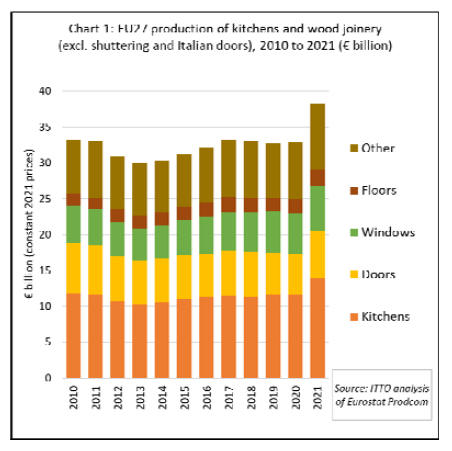
In 2021, the impact in the COVID-19 recovery plans on
long-term economic and social ¡°resilience¡± was felt
particularly strongly in the joinery sector.
NextGenerationEU, the €750 billion ($888 billion)
economic recovery instrument rolled out across the EU
from 2021 in response to the pandemic, is explicitly linked
to the EU Green Deal, a radical project to cut EU
emissions by 55% compared to 1990 levels by 2030 on the
way to making the EU climate neutral by 2050.
37% of NextGenerationEU finance is earmarked for
achievement of European Green Deal objectives with
activities including a large program of building renovation
and support for the ¡°circular economy¡± and sustainable
investment. The projected costs of these Green Deal
measures are enormous, requiring an additional €82 billion
to €147 billion in spending every year until 2030, about
half a percentage point of the EU¡¯s GDP. Beyond 2030,
the additional investments are 1% to 2% of GDP, about
€4.6 trillion between 2031 and 2050.
Nowhere has the impact of these measures been greater
than in Italy. In fact the effect is so strong that the Eurostat
PRODCOM data for Italian door manufacturing in 2021 is
so high as to suggest it may be exaggerated. For this
reason it is not included in the EU-wide analysis (which it
would otherwise distort) and is considered separately
below.
Eurostat reports fivefold increase in value of Italian
wood door production
According to Eurostat data the value of wood door
production in Italy increased nearly five fold from €680
million in 2020 to €3.8 billion in 2021 (Chart 2). If
accepted at face value, this would imply that Italy alone
accounted for around 40% of the total value of all wooden
doors manufactured in the EU last year. In terms of
quantity, Italy¡¯s production is recorded as increasing from
just 2.4 million door sets in 2020 to 9.4 million door sets
in 2021.
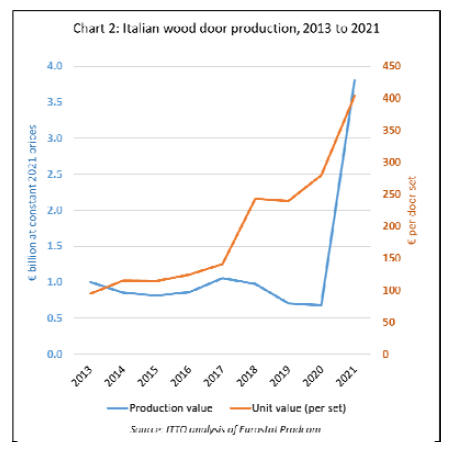
There is, possibly, a legitimate explanation for such a huge
increase in Italian wood door production.
A key feature of Italy¡¯s post-COVID support measures in
the construction sector, partly financed through
NextGenerationEU, was the so-called ¡°Superbonus¡±
scheme for building renovations.
This was originally introduced in May 2020 as part of
Italy¡¯s ¡®Relaunch Decree¡¯ adopted in the wake of the
pandemic. It aimed to boost the Italian economy by
providing incentives aimed at improving building energy
efficiency. The scheme allows homeowners to set 110% of
the costs building renovation against tax, effectively
allowing them to renovate at no cost. The scheme is due to
end in 2025.
Given that Italian door production was at a level of around
10 million units per year in 2013, before declining during
the long period of stagnation in Italy¡¯s joinery sector to
around 3 million units in 2019 before the pandemic, a
production figure of 9.4 million units last year is just about
conceivable.
This is particularly true when it is considered that
replacing old doors with new modern energy efficient
designs is probably one of the most immediately effective
measures to reduce energy consumption in the existing
housing stock. Indeed, this is the type of measure that led
the EU to praise Italy¡¯s Superbonus scheme for boosting
the decarbonisation of the building sector, which is
estimated to account for around 40% of energy use and
36% of CO2 emissions in Europe.
As of 31 July 2022, more than 220,000 renovation projects
with a total value of €40 billion had been accepted under
Italy¡¯s Superbonus scheme, according to data from the
Italian National Agency for New Technologies, Energy,
and Sustainable Economic Development (ENEA).
The scheme had a ¡°formidable positive impact¡± on the
Italian economy, according to the National Council of
Engineers (CNI). By the end of 2021, the subsidies
contributed to the generation of more than €12 billion in
Gross National Product (GDP) and the creation of 153,000
jobs, the association said in a study.
The Superbonus scheme, which likely lies behind the
sharp rise in Italian door production, therefore has had
some very positive effects. On the other hand, the
extremely rapid rise in unit costs of wood doors in Italy
last year hints at some potential problems due to such
large subsidies. The average unit cost of wood door
production in Italy last year was €404 per set, 70% more
than before the COVID crises.
A significant increase in the costs of door production can
be expected due to sharply rising costs of materials,
energy, and other business since the start of the pandemic.
However, the rise in the unit cost of doors in Italy is out of
line with other EU countries. Last year, the unit value of a
wood door produced in Italy was more than seven times
the average (€57 per set) of wood doors produced in other
EU countries.
This lends weight to comments by Prime Minister Mario
Draghi to the European Parliament in May this year when
he suggested that the Superbonus scheme had led to
market distortions. ¡°The cost of improving efficiency has
more than tripled due to the 110% scheme.
The prices of the investments needed to perform the
renovations have more than tripled because the 110%
eliminates the incentive to negotiate on price,¡± he
remarked.
Slow but steady rise in German wood joinery sector
Last year¡¯s rise in the value of joinery manufacturing in
other EU countries, and in joinery sectors other than doors
in Italy, was less dramatic but still significant. (Chart 3).
The value of joinery production in Germany, which unlike
other leading joinery manufacturing countries in Europe
continued to grow in 2020, increased by 3% to €10.30
billion in 2021.

In all the other large joinery manufacturing countries there
was a sharp increase in joinery production value last year
following a decline in 2020. Gains were made in France
(+23% to €5.14 billion), Austria (+23% to €2.99 billion),
Poland (+16% to €2.51 billion), Sweden (+4% to €1.98
billion), Spain (+61% to €2.16 billion), Denmark (+53%
to €2.05 billion), and the Netherlands (+6% to €1.20
billion). Production value of all joinery products other than
doors in Italy increased 23% to €5.14 billion in 2021.
No sign of an increase in wood¡¯s share of the EU door and
windows sector.
While wood joinery activity increased significantly last
year across the EU, there is little evidence to suggest that
wood products increased their overall share of the EU
market for doors and windows. Eurostat PRODCOM data
provides comparable data on the total value of doors and
windows manufactured in the EU27 in wood, plastic, steel
and aluminium respectively. This shows that the value of
metal and plastic door and window production in the
EU27 increased alongside production of equivalent
products in wood (Chart 4).
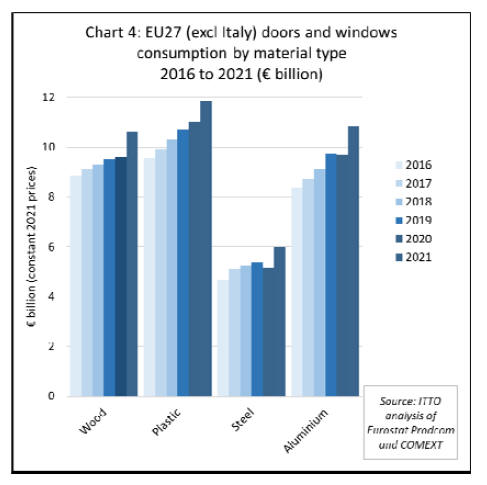
The share of wood in the total value of EU27 door and
window production was 27% in 2021, the same proportion
as the previous year. The share of steel also remained the
same last year, at 15%. The share of aluminium marginally
increased, from 27% to 28%, while plastics share declined
slightly, from 31% to 30%.
The continuing rise in aluminium follows a longer-term
trend.
Aluminium has always remained the default windows
product in the commercial market but has enjoyed
considerable resurgence within the residential window and
door market. An important driver behind this has been
aluminium bi-fold and sliding doors as consumers demand
greater space and light within living areas. Another factor
is the demand for lower maintenance and greater strength
in light weight frames for high energy efficiency double
and triple glazed units.
A limitation of the PRODCOM data is that it does not
distinguish products made wholly in wood or metals from
those that are composites of both materials. The
development of wood-aluminium composite window
frames has been a key growth area in the EU27 in recent
years. These products combine the strength and efficiency
of aluminium with the thermal insulation and aesthetic
properties of wood.
EU market for wooden doors rebounded 12% last year
Eurostat PRODCOM data shows that the total value of
wood doors supplied to the EU27 (excluding Italy)
increased 12% to €6.50 billion in 2021 following a 1%
decline the previous year.
In 2021, 96.6% of the value of all new doors installed in
the EU27 were manufactured inside the single market,
only 3.4% were imported from outside (Chart 5).
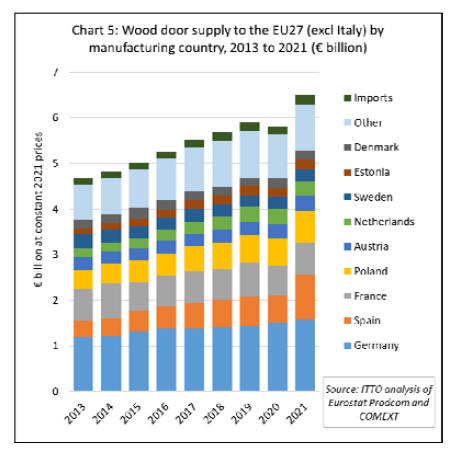
Although the trend was generally upwards, there was
variation in the performance of the wood door sector in
EU27 countries in 2021 (Chart 5). Production in Germany
increased 5% to €1.50 billion during the year, continuing
an uninterrupted rise since 2009. Production in Spain
rebounded very strongly, by 64% to €970 million in 2021
after a 10% fall in 2020.
Production in France also rebounded, but less strongly by
only around 4% to €700 million after an 8% decline in
2020. Elsewhere in 2021 there was a robust rise in wood
door production in Poland (+16% to €700 million), Austria
(+10% to €340 million), and Estonia (+20% to €230
million). Production fell in the Netherlands (-5% to €330
million), Sweden (-4% to €250 million) and Denmark (-
9% to €200 million). (Chart 6)
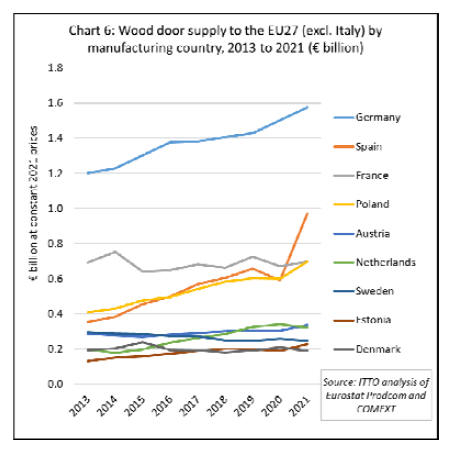
Following a 4% decline in 2020, wood door imports into
the EU27 increased by 17% to €221 million in 2021
(Chart 7).

Total EU27 wood door imports from the tropics were
€49.8 million in 2021, 21% more than in 2020. This
compares to a 16% increase in imports from temperate
countries to €172 million in 2021. The share of EU27
wood door imports sourced from tropical countries
increased slightly, from 21.9% in 2020 to 22.5% in 2021.
This redresses the loss of share during 2020 when tropical
suppliers were particularly hard hit by rising freight rates
and other supply problem in the early stages of the
pandemic.
In 2021, wooden door imports from Indonesia, by far the
largest tropical supplier, rebounded 31% to €42.5 million,
after falling 8% the previous year. Imports from Brazil
also rebounded, but by only 7% to €3.9 million after also
falling 8% the previous year. In 2021, EU27 imports of
wood doors fell sharply to negligible levels from Malaysia
(-30% to €1.8 million) and Vietnam (-49% to €0.8
million).
EU27 imports of wooden doors from China, still the
largest single external supplier, rebounded 19% to €59.6
million in 2021 after falling 14% the previous year.
Imports from Ukraine increased 24% to €20.2 million in
2021 building on a 22% increase the previous year.
EU27 wood door imports from the UK fell 14% to €12.0
million in 2021 owing to changing distribution networks
after the UK left the EU single market at the start of the
year.
The European wood door industry is now dominated by
products manufactured using engineered timber driven by
requirements to comply with higher energy efficiency
standards and efforts to provide customers with more
stable products and long-life time guarantees.
Another key trend is towards composite doors with a steelreinforced
uPVC outer frame with an inner frame
combining hardwood and other insulation material. These
products are designed to combine strength, security,
durability, high energy efficiency, with a strong aesthetic.
There may be a place for tropical hardwoods in the design
of these products with manufacturers looking to combine
high quality, consistent performance, regular availability,
and good environmental credentials with a competitive
price.
EU market for wood windows up 15% in 2021
The total value of wood windows supplied to the EU27
increased 15% to €6.59 billion in 2021 following a 4%
decline the previous year. This was the first annual
increase since 2017 in a market which had been effectively
static since before 2008 financial crises (Chart 8).
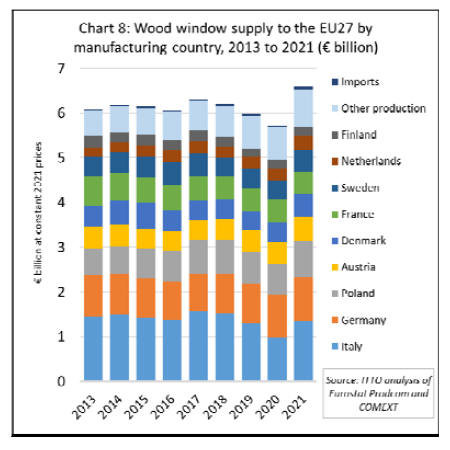
Supply of wood windows to the EU27 is overwhelmingly
dominated (over 99%) by domestic production which
increased 15% to €6.54 billion in 2021. The strongest
rebound was in Italy where the value of wood window
production increased 38% to €1.35 billion after a 25% fall
the previous year (although the scale of the rebound in the
Italian windows sector may, to some extent, be inflated for
the same reasons as in the Italian door sector).
Wood window production in Germany increased by 2% to
€980 million in 2021, continuing a rising trend ongoing
since 2018. Production in Poland increased 15% to €800
million after a 2% decline the previous year.
Gains were also made in all other leading wood window
manufacturing countries in 2021 including Austria (+13%
to €550 million), Denmark (+16% to €510 million),
France (+1% to €500 million), Sweden (+11% to €480
million), and the Netherlands (+11% to €310 million)
(Chart 9).
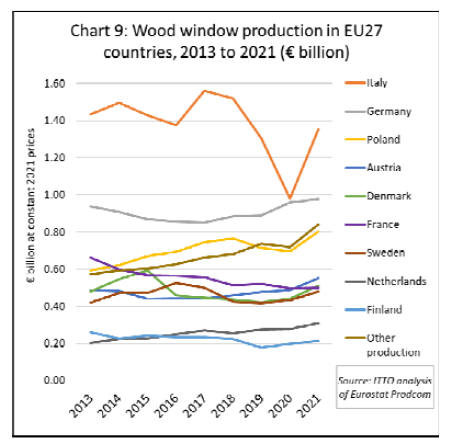
EU imports of wood windows from outside the EU
increased by 36% in 2021 to €51.2 million (Chart 10).
Imports from Belarus, the largest external supplier last
year, increased 26% to €9.7 million in 2021, continuing a
rising trend that started in 2017. Imports also increased
sharply from Bosnia (+170% to €9.1 million), and the UK
(+107% to €8.5 million). However imports from Norway
fell 16% to €6.1 million.
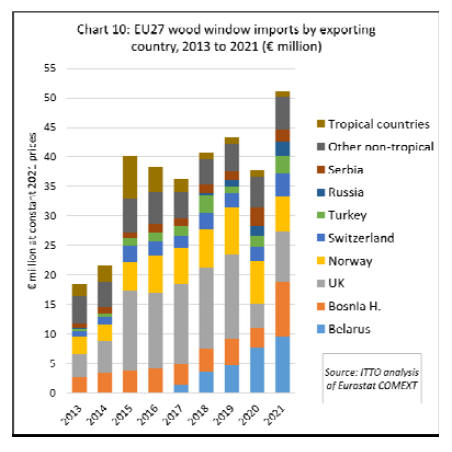
Only a tiny quantity of wood windows is imported into the
EU from tropical countries. After a spike in imports of €7
million in 2015, mainly from the Philippines, imports from
tropical countries fell to less than €1 million in 2019 and
remained at that level in 2020 and 2021.
While tropical countries are not significantly engaged in
the EU market for finished windows, this sector is of
interest as a source of demand for tropical wood material.
From this perspective, a notable long-term trend in the EU
window sector ¨C as in the door sector - is towards use of
engineered wood in place of solid timber. This is
particularly true of larger manufacturers producing fullyfactory
finished units that buy engineered timber by the
container load.
Increased use of engineered wood is closely associated
with efforts by window manufacturers to meet rising
technical and environmental standards, provide customers
with long lifetime performance guarantees and recover
market share from other materials.
Increased focus on energy efficiency means that tripleglazed
insulating window units with very low U-factors
are now more common than double-glazed units in
Europe. These units demand thicker, more stable and
durable profiles that in practice can only be delivered at
scale using engineered wood products or by combining
wood with aluminium and steel in composite products.
The quality and engineering of wood windows has
undergone a revolution in the EU in recent years so that
manufacturers are now able to deliver products with many
of the benefits previously reserved only for the best quality
tropical hardwood frames using softwoods and temperate
hardwoods.
Factory-finished timber windows are given a specialist
spray-coated paint finish for even and durable coverage
which might only need redoing once a decade. The
lifespan of factory-finished engineered softwood frames is
now claimed to be about 60 years, while thermally or
chemically modified temperate woods can achieve around
80 years.
Nevertheless, smaller independent joiners producing
bespoke products in low volumes still tend to rely on solid
timber purchased from importers and merchants to
manufacture window frames. Tropical woods such as
meranti, sapele and iroko continue to supply a high-end
niche in this market sector.
Sharply declining prospects for European wood
joinery sector in the third quarter
Joinery sector activity in the EU27 was still quite high in
the first half of 2022; the Eurostat manufacturing index for
joinery (excluding flooring) indicated activity during this
period at around 15% above the level prevailing in 2019
before the onset of the COVID pandemic. However,
prospects for the rest of this year have declined sharply in
the third quarter.
The S&P Global Eurozone Construction Total Activity
Index was below the no-change mark of 50.0 for the fourth
successive month in August and fell to 44.2 from 45.7 in
July. The latest figure signalled the fastest decline in
activity in the building sector since January 2021. The
three largest euro economies all posted steeper
contractions with Italy (41.2) seeing the fastest overall
decline, followed by Germany (42.6) and France (48.2)
respectively.
Broken down by sector, all three categories recorded faster
and similar rates of contraction. Civil engineering
registered the steepest decline, and housing the weakest,
although the latter still posted the fastest drop in activity
since May 2020.
Commenting on the latest results, Trevor Balchin,
Economics Director at S&P Global Market Intelligence,
said: "Construction companies in the eurozone endured a
deepening downturn in August, with seasonally adjusted
activity dropping the most than in any month since
January 2021.
¡°Whereas the previous period of decline reflected COVID-
19 restrictions, the latest downturn is being driven by a
darkening economic outlook amid high inflation and
uncertainty caused by the ongoing war in Ukraine. All
three of the largest euro economies recorded lower
activity, new orders, employment and purchasing in
August.
"There was further evidence that cost pressures may have
peaked but this failed to arrest weakening confidence in
the 12-month outlook, which in August was the worst
since the first COVID lockdown in spring 2020."
The increasingly negative outlook in the construction
sector reflects mounting problems in the wider European
economy. A recent article in the Economist commenting
on European prospects notes that ¡°Every single warning
light is flashing red. Russia¡¯s war on Ukraine, an uneven
recovery from the covid-19 pandemic and a drought across
much of the continent have conspired to create a severe
energy crunch, high inflation, supply disruptions¡ªand
enormous uncertainty about Europe¡¯s economic future.
Governments are rushing to try to help the most
vulnerable. Amid the nervous confusion, there is broad
agreement on one thing: a recession is coming¡±.
According to the Economist, quite how bad the downturn
turns out to be depends on how the energy shock plays
out, and how policymakers respond to it. At the end of
August, energy prices reached once-unimaginable heights:
more than €290 (US$291) per megawatt hour (mwh) for
benchmark gas to be delivered in the fourth quarter of the
year (the usual pre-pandemic price was around €30); and
more than €1,200 per mwh for daytime electricity for the
same quarter in Germany (up from around €60). Because
gas is the marginal fuel in most European electricity
markets, it sets the price for power more broadly.
With energy costs so high and the outlook uncertain, both
business and consumer confidence are declining sharply.
Concern is heightened by the fact that Europe will almost
certainly see the energy shock coincide with rising interest
rates. According to the Economist ¡°Having underestimated
price increases along with many other of the world¡¯s
central banks, the ECB [European central Bank] is now
determined to bring annual inflation back to its target of
2%, from the alarming 9.1% recorded in August.
Economists therefore expect the ECB to try to buttress its
inflation-fighting credentials with a substantial interestrate
rise in its next policy meeting on September 8th,
possibly lifting rates by three-quarters of a percentage
point¡±.
The Economist concludes ¡°all this suggests that the
European economy is certain to enter a recession, led by
Germany, Italy, and central and eastern Europe. Analysts
at JPMorgan Chase, a bank, expect annualised growth
rates of -2% for the euro area overall in the fourth quarter
of this year, -2.5% for France and Germany and -3% for
Italy¡±.
|